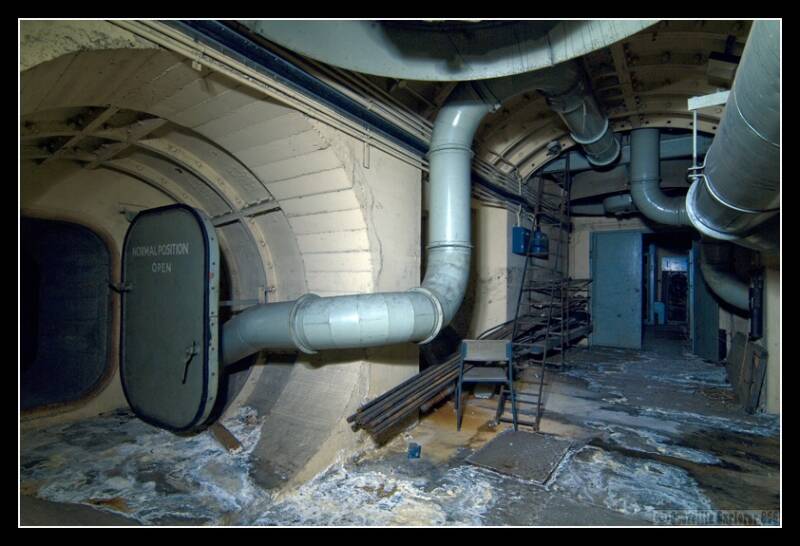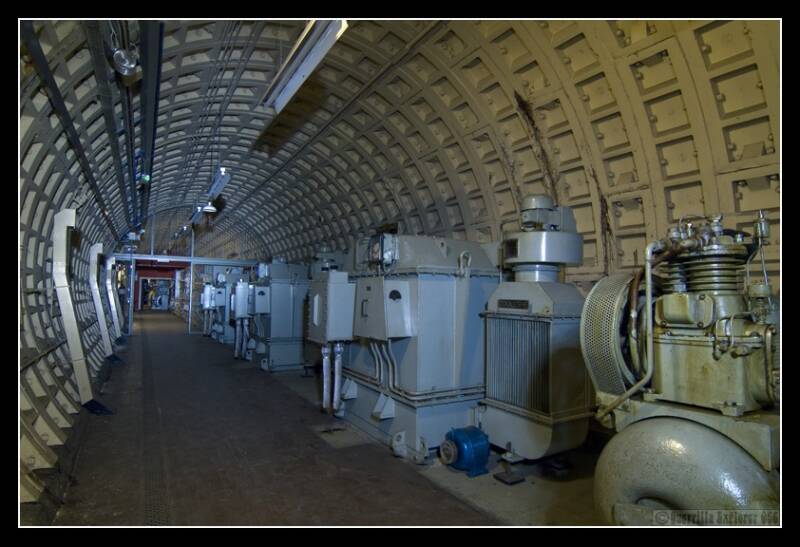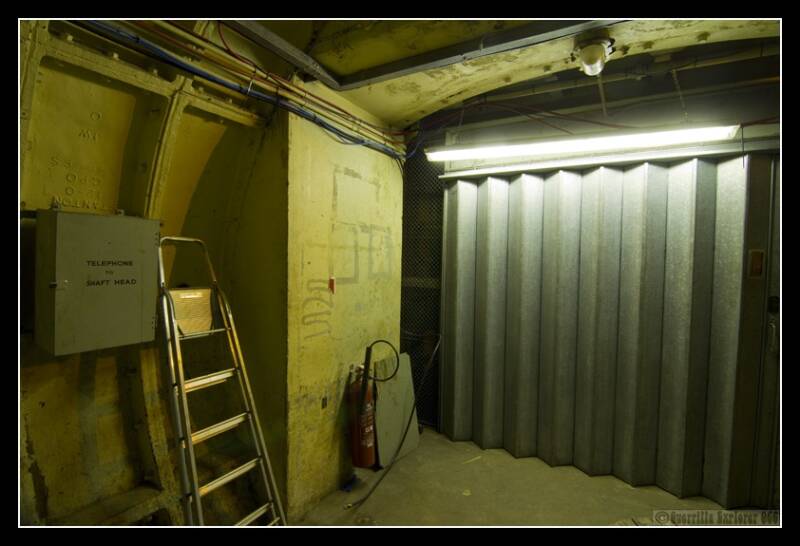GES227 - Kingsway Exchange, London
This was originally the Chancery Lane Deep Level Shelter, built in 1942, and like other deep level shelters, consisting of two tubes 365m long. It was envisaged as a place to let people hide from the Luftwaffe in the second world war. However, with the Luftwaffe defeated, there was little need for it, and the MoD took an interest. It was used as a solider barracks, and then a Government communications centre. MI6 were based here.
The shelter was vacated after the war, and the Public Records Office stored material here, however after a few years, soon ran out of space. The Goverment were also looking to secure the communication links in London, and were eyeing this deep level sheter. In 1949, the Public Records Office vacated, and the Goverment and the General Post Office (in charge of communications) moved in. When they did, various alterations were made to accommodate them. These include the 4 Avenues, and change of lift from passenger to Good's Lift at Furnival St. The 'Trunk Zone Exchange Kingsway' opened in 1954. 2 years later it became the London Terminal of the first transatlantic telephone cable, this included the hot-line between the White House in the USA and the Kremlin in the USSR. The Exchange remained on the official secrets list until 1966, 3 years later stories were printed about it in the press.
Technology improvements meant that by 1979 it was obselete, and operations moved to the Houndsditch centre. In the following decade, the Exchange was used for various British Telecom (BT) projects, BT being the nationalised name for the now sold off GPO. These included new services, such as cctv and computer networks etc. Also around this time, the Goverment acquired two of the Avenue tunnels, believed to be a temporary accomodation for those involved in the construction of the Pindar network under Whitehall. The shadowy figures had exclusive use of the Tooks Court entrance, and didn't mix with BT employees. By 1990 the Exchange was only used for storage. In 2001, the Took's Court exit was sold and demolished, in 2008, the Exchange was put on the open market for suitable buyers.

In a 2008 news report on the sale of the Kingsway Exchange, a mere 5 years ago, BT dictated that the news team couldn't feature the street view of the front of the building, nor state the name of that street. This seems odd, as anyone wanting to know could have found the information online. This is the front door at Furnival Street, click here.
The other side of the doors, as shown in the news report, are here, and open out onto Furnival St. However as they're likely alarmed, we weren't interested in doing that. Using an old exploit from the nearby tube station is a much easier and safer option. 180 degrees from this pic will be the good's lift.

Wary of what might happen if we used the lift, we opted for a long set of ladders that sit next to the Goods lift. Halfway down is some sort of ventilation tunnel that does down to No.2 shaft disused. Around the corner in the picture is a large ventilation fan, sat in it's own little room. Behind the fan is a stairwell in the No.2 disused vent shaft.

The stairwell on the right leads down from the ventilation tunnel above in No.2 shaft.

Behind the camera in the pic above, one can walk though a cramped section, where the tunnel is split down the middle from floor to ceiling. The section is only about 30m long, and ends in the photo below. This is looking through the section towards the No.2 shaft. Note the locks on the metal door just inside the mesh gates, making one wonder if was air-tight.

A group of old fuse boxes or something, just on the left in the above pic. Some looking older than others.

Some old boilers maybe, sat next to the pic above. In the background the pic above the one above. Behind the camera, a 20m tunnel leads off, with the two large pipes on the ceiling seen here. It ends at a shaft leading up to the surface. Probably capped decades ago.

Back in the No.2 shaft, the spiral stairs continued down a short way to the section in the pic below. The ladders lead to a landing at the level of the main tunnels of the exchange. Another ladder leads down to what might be called a basement section.

Similar to the other deep level shelters in London, there is a basement section, often leading to a room with some electrical cabinets of some kind. Also there is a mercury rectifier, again common to all deep level shelters. What is not common, is that branches that occur here. Two branches on either side lead off on a short 'j' style tunnel with water covering the floor at the end. As can be seen, the doors into the 'j' tunnels have seals on. Above each entrance to the 'j' tunnel is a large fan on the ceiling.

Looking in one of the 'j' shaped tunnels. Beyond what can be seen, it bends to the left for about 5m and ends in a locked door above a pool of water.

The end of the basement section. I've been in numerous deep level shelters, but never managed to capture the beauty that is these cabinets that appear in every one. I've clearly failed again here. On the left is the mercury arc rectifier.

We proceeded upstairs, and started to explore the two main tunnels, officially referred to as 'Streets'. This is South Street.

Part of the Ventilation system on South Street.

The tunnel is split in half vertically here, with offices for engineers filling one half, and South St the other.

Feeding off South St are 4 'Avenues', built on a much larger diameter tube than the main streets. If you removed the ceiling boards and floor, you'd have a huge round tunnel. This is Third Avenue. On the right of Third Av, is Fourth Av, which looks identical. First and Second Av are all partitioned off, so lack the full open space. As mentioned above, the Avenues were built after the war, when this became a full time exchange.

Rectifier cabinets on South St. Ahead through the grey doors lie various offices and later the recreation areas.

The junction of South St with Oil Close. Voltage monitoring cabinets lie further up South St.

High voltage section on South St.

I don't know why, but after the first visit, I just visualised this photo. On the second trip, I took the shot. Thankfully the others had disappeared elsewhere. This is the bar area.

Beyond the bar area were a couple of empty rooms, ending in a spiral staircase down to a small foot tunnel, that crosses back to the the canteen/dining area. On the map it's referred to as 'West Alley', it emerges behind the camera in this shot. Once upon a time this area would have been full of dining tables. Faded old pictures fill alcove windows on the left. The door next to the wavy metal partition leads across to the recreation rooms, making one wonder why West Alley was built?!?

Looking into the kitchen areas of the canteen, serving hatch on the left.

The hungry diners interaction point at the serving area. The door leads off down North Street.

The lift up to Chancery Lane Tube station, 2 floors above.

Kingsway Computer Centre, constructed after the Exchange was mostly closed down/obsolete.

More of the Kingsway Computer Exchange, with the odd addition of doors that open onto the walls of the tunnel that it's situated in.

North St East, mostly empty with ventilation pipes of some kind. At the bottom end, a passage cuts back into South Street.

Back in South Street, the entrance to Goods Alley and the Main Distribution Frame (MDF), stil standing.

The MDF, located in Goods Alley. A first aid centre exists up some stairs on the right of the camera. Now just an empty room.

The junction at the end of Goods Alley. On the left is the Furnival Street Goods Lift, straight ahead is a smaller tunnel that leads to the Deep Level Tunnel network. It's sealed off with wooden boarding, beyond that is heavy security involving cctv and pir alarms. On the right is Goods Avenue.

Goods Avenue leads into various service areas, as well what looks like a lunch area of some kind at the bottom end of First or Second Avenue.

Some sort of aged fuse board on Service Avenue. Service Avenue was split vertically, with plant and such like on one side, and a corridor on the other. Underneath the plant area, I delved around for evidence of the Artesan Well that's marked here. I found a covered area with a small amount of water in a metre down. I'm guessing this was the well. At the end of Service Avenue were a few empty office like rooms.

Leading off the end of Service Avenue is South Avenue. We came to a gate that seemed to close off access any further. However it was open, and we crept along further. We spotted a camera on the ceiling, with a light pir (it switches on a light rather than an alarm when detecting a new heat source). I quickly nipped forward and looked around. The camera was basically looking at the Tooks Court Lift, judging by the look of it, I doubt it was going to be used anytime soon. To the side were a set of stairs in a similar state of repair. All available information points to the shaft being capped, so i didn't waste time climbing the stairs.

We went back to the Goods Alley junction, and a quick look at the Goods Lift up to Furnival Street. Most official visitors enter the exchange this way. We, did not!

After two trips and numerous hours spent here, we felt compfortable about not being caught. As long as we didn't attempt to access the Deep Level tunnels, we'd be fine. Another group of explorers had been here some months before us and did access the Deep level tunnels, and all hell broke loose apparently. We left back into the night air and went our separate ways.
More in-depth information can be found here.
Add comment
Comments